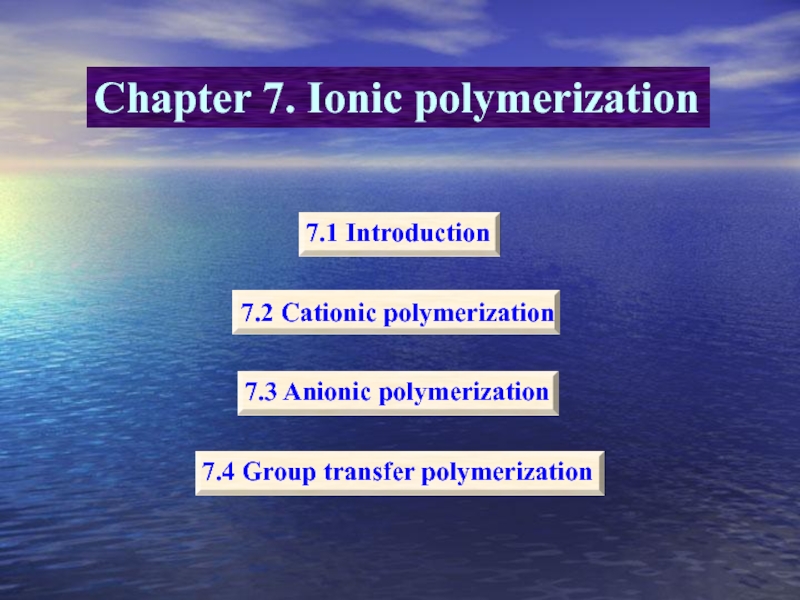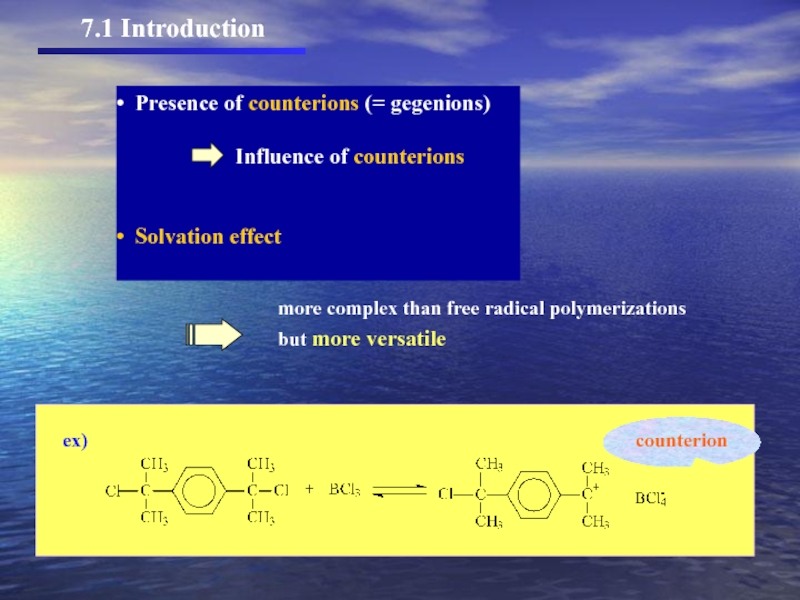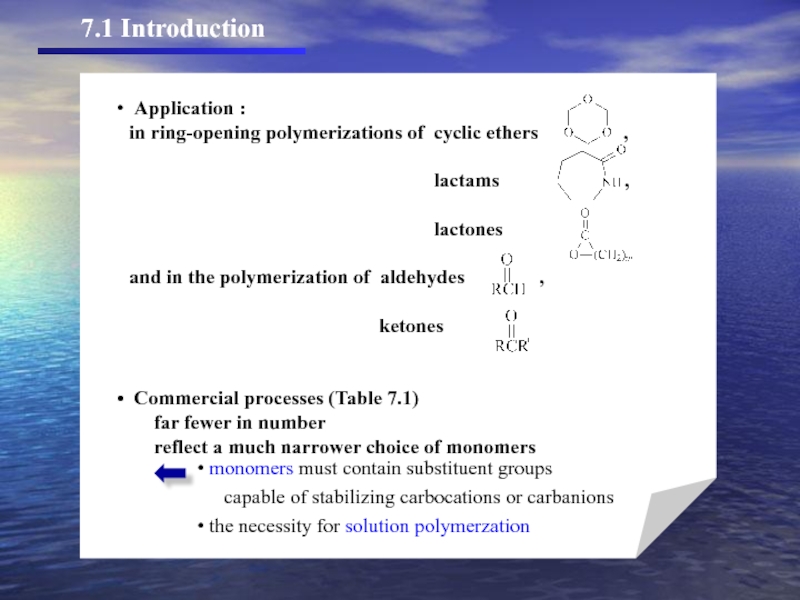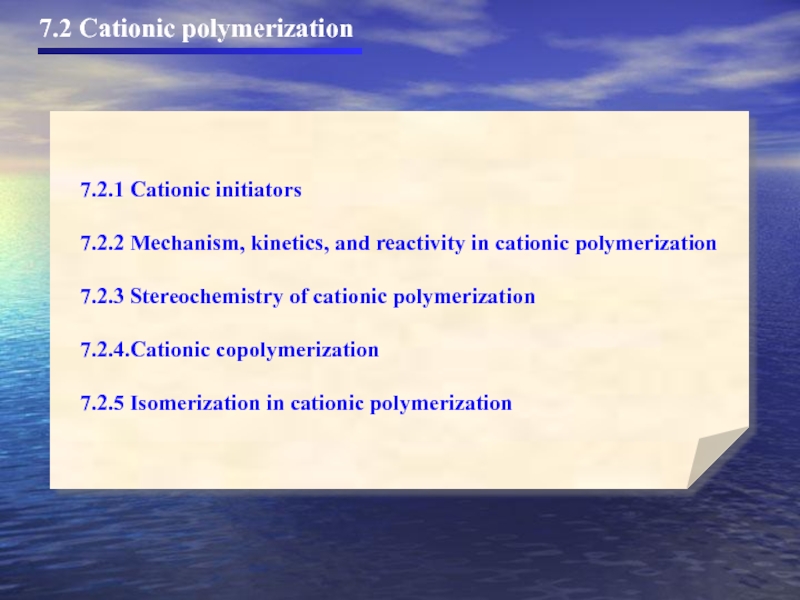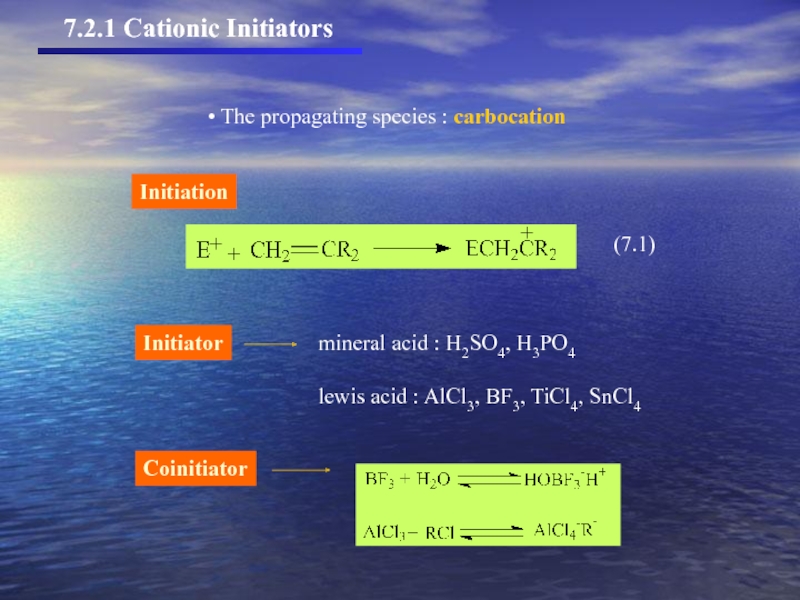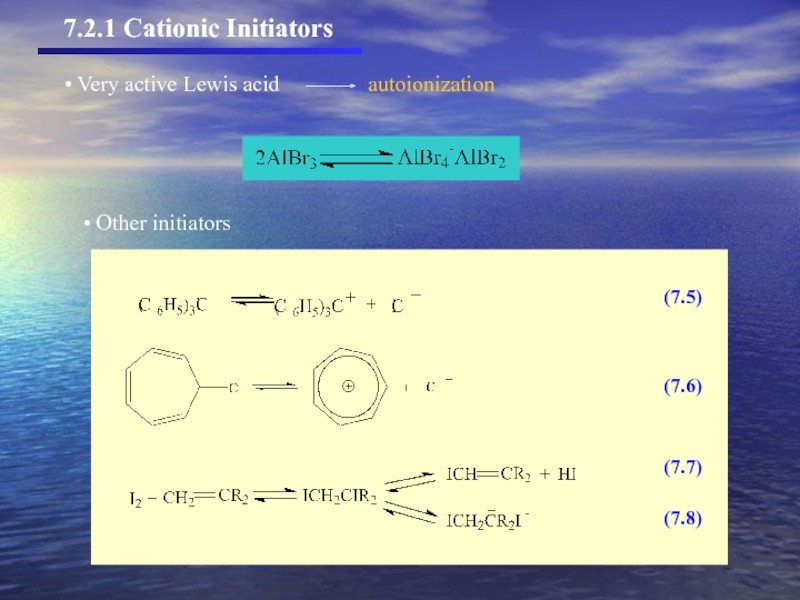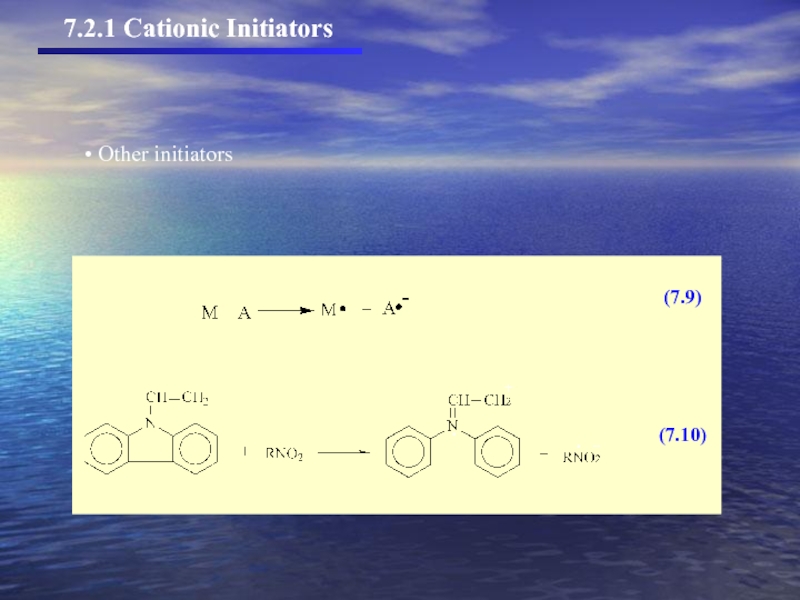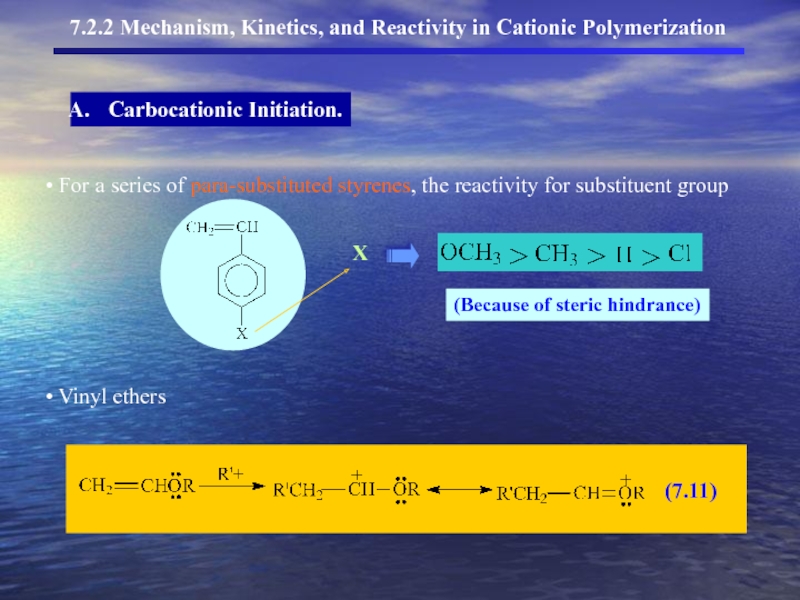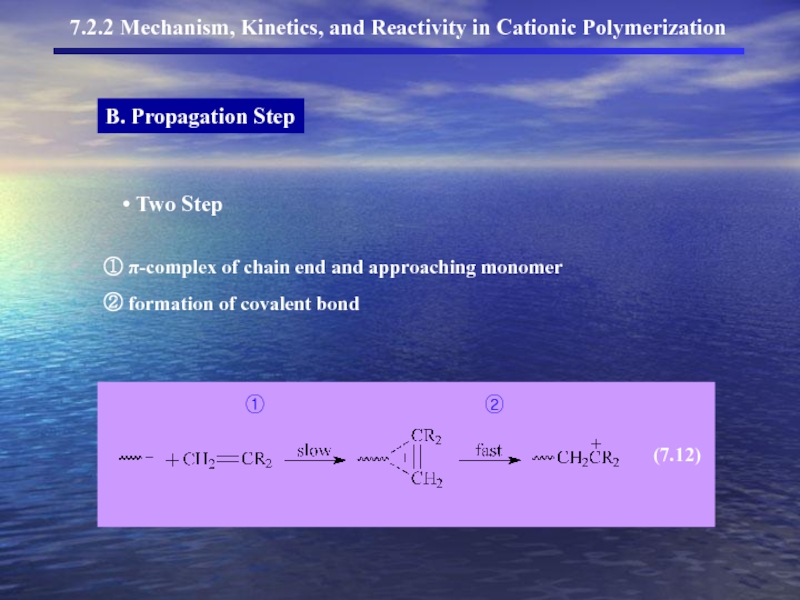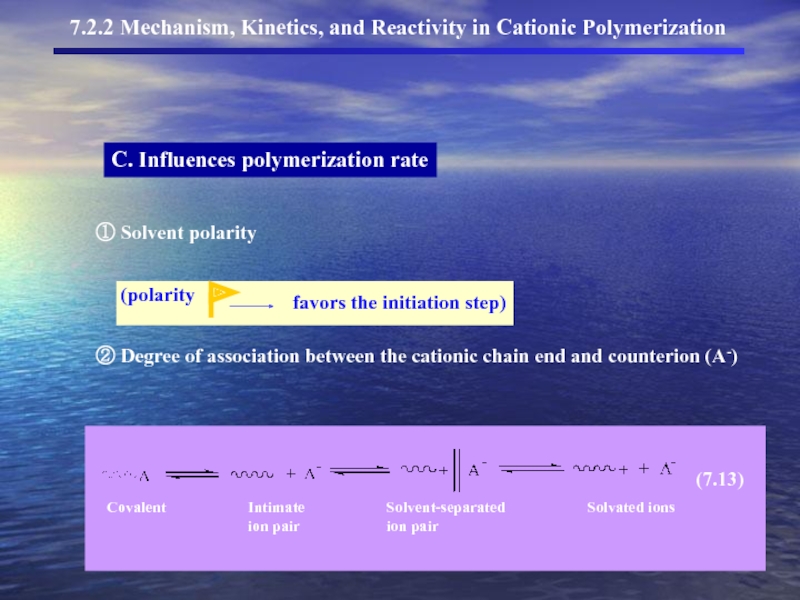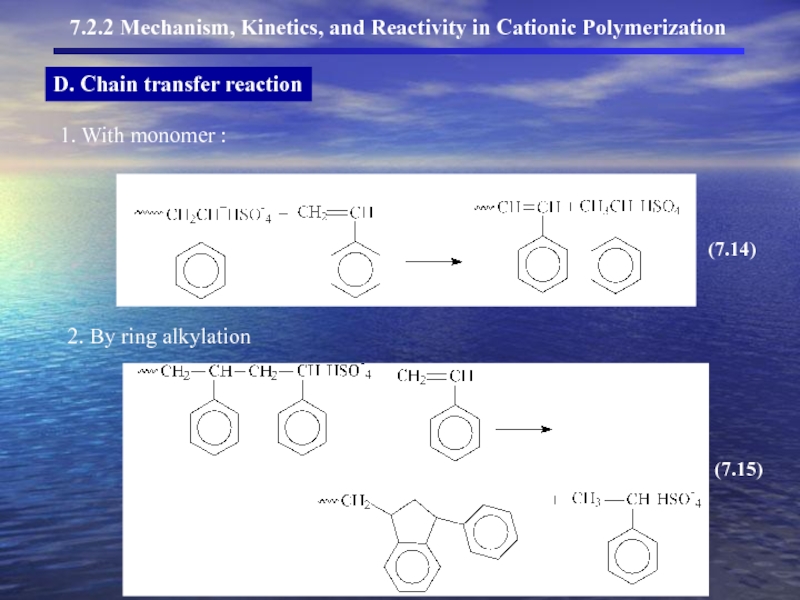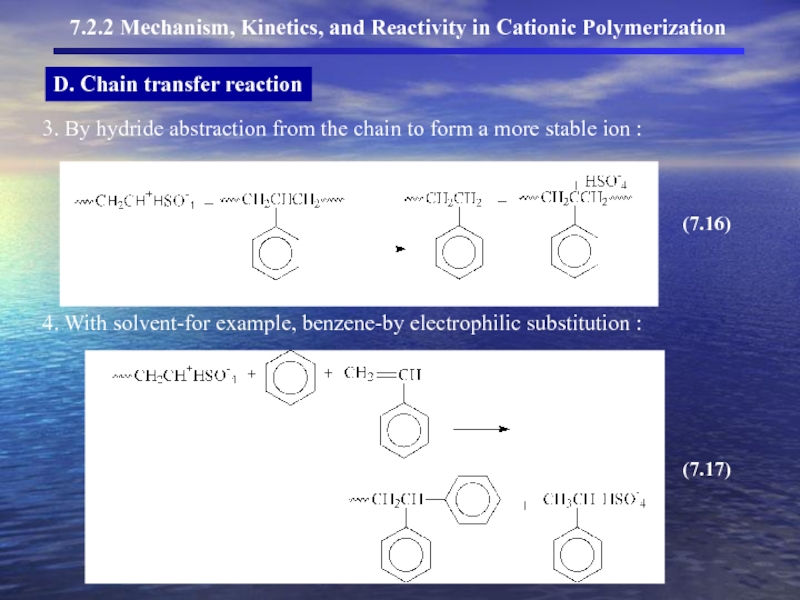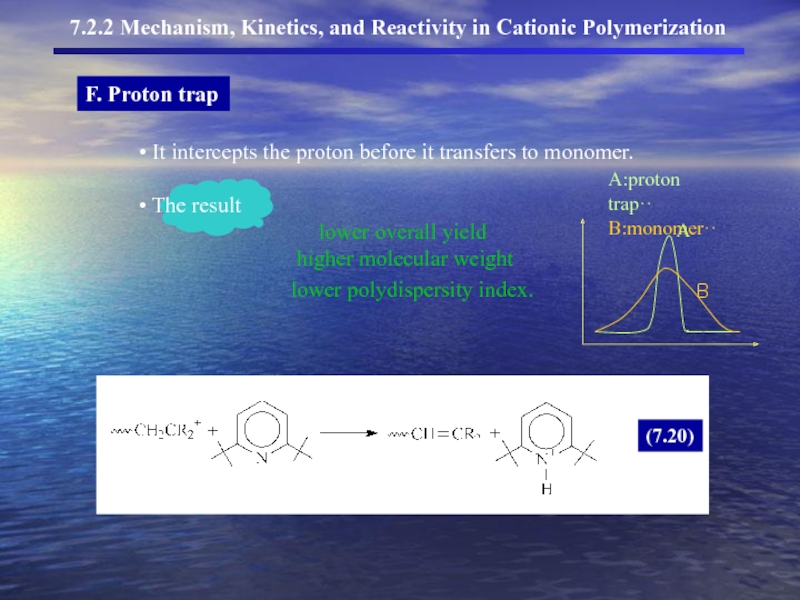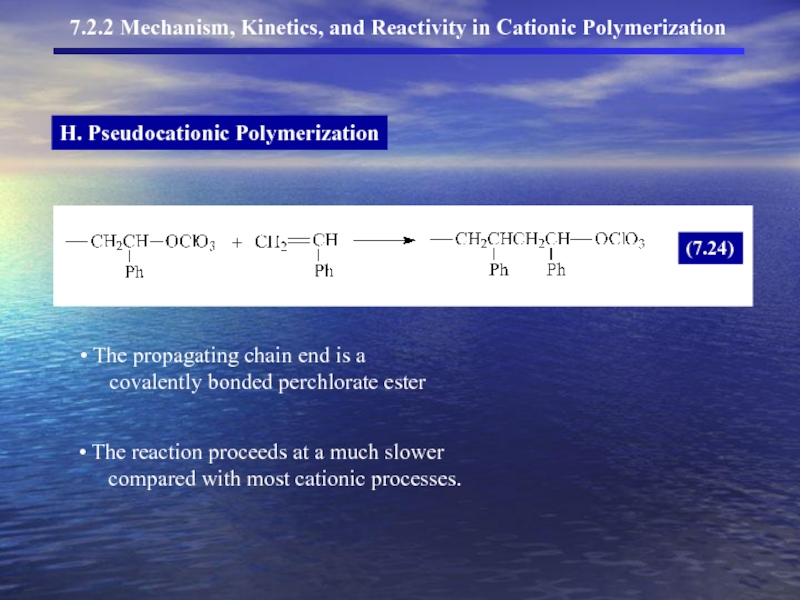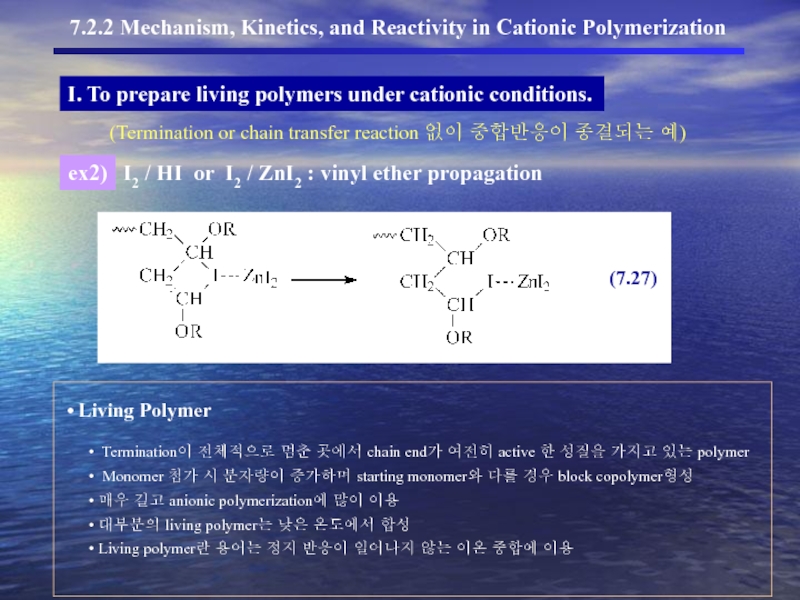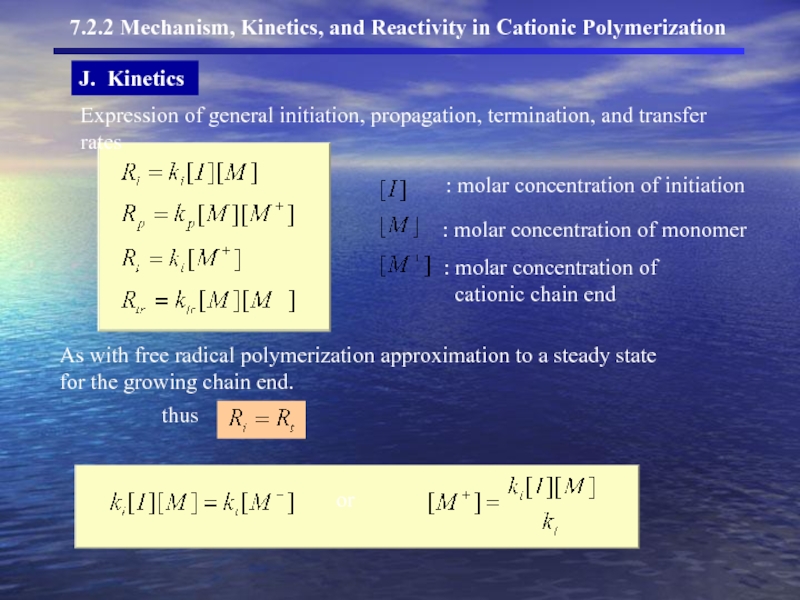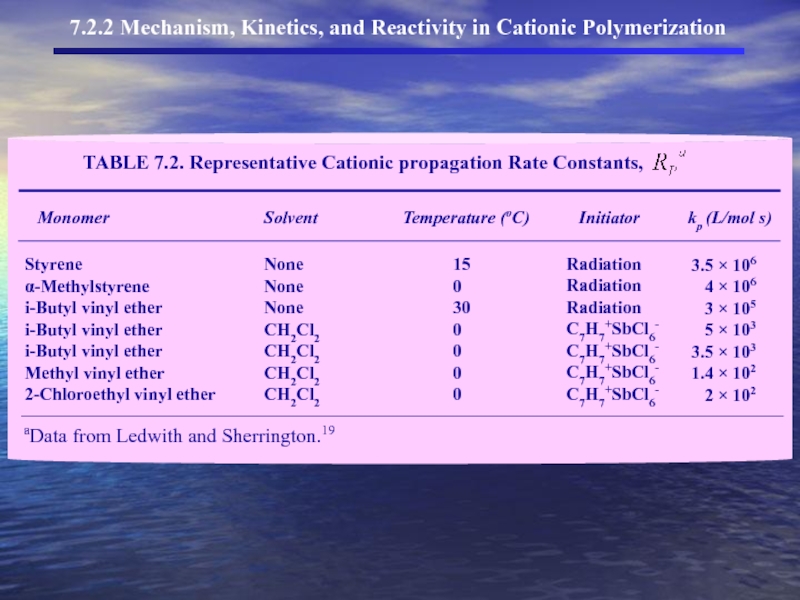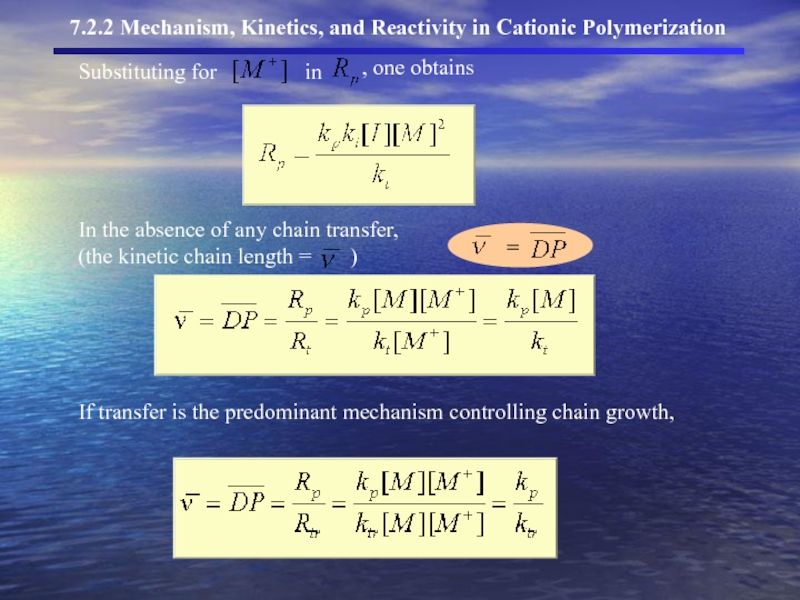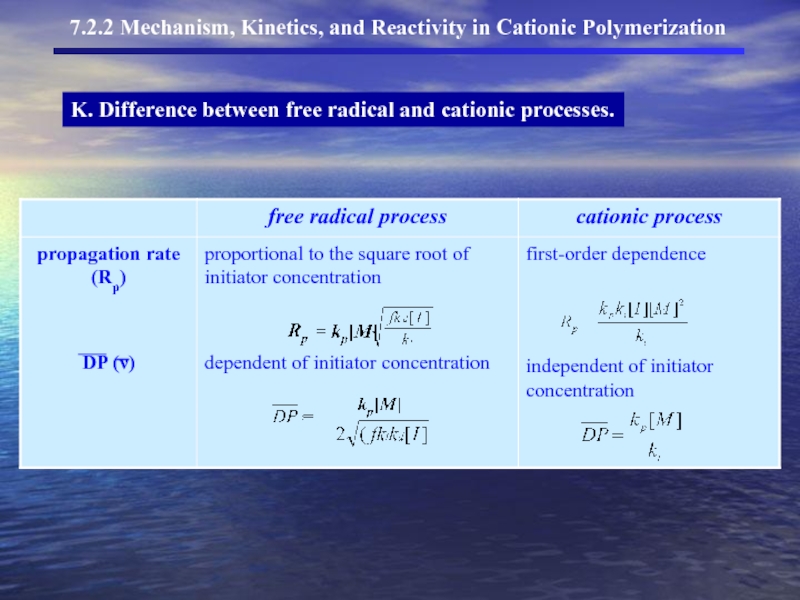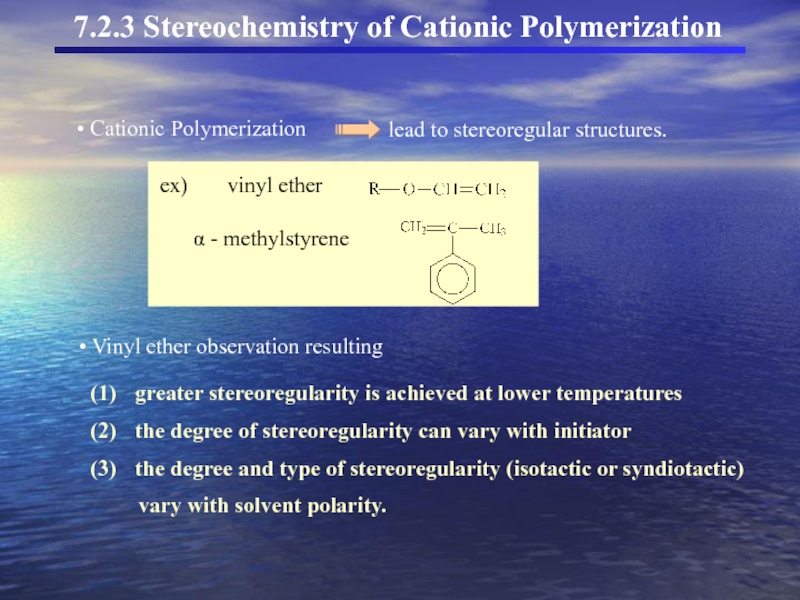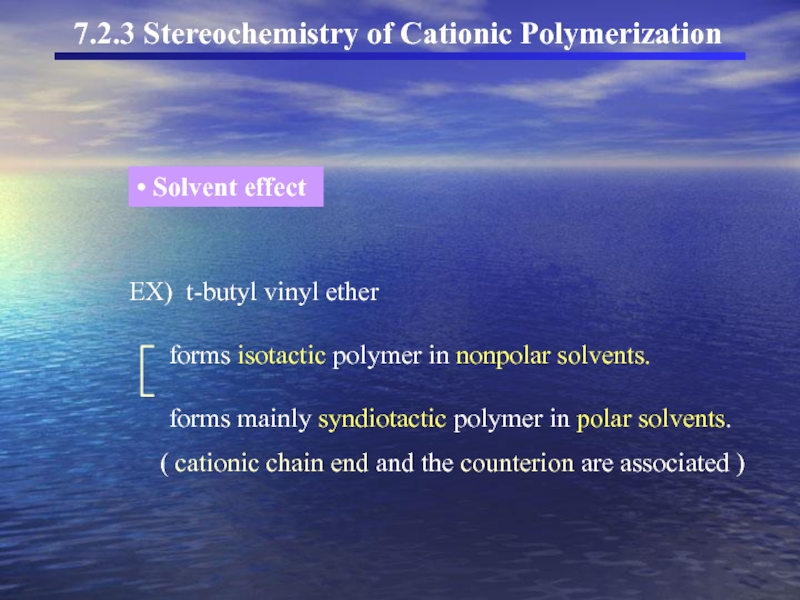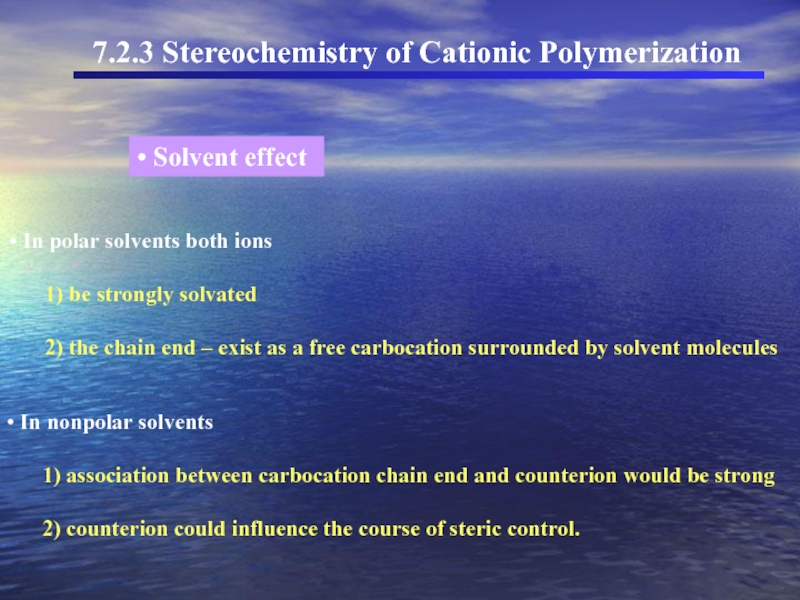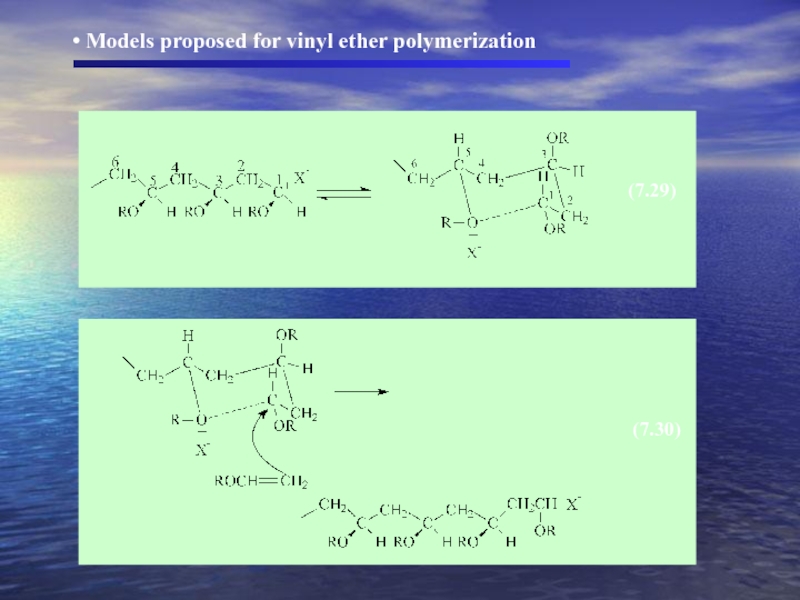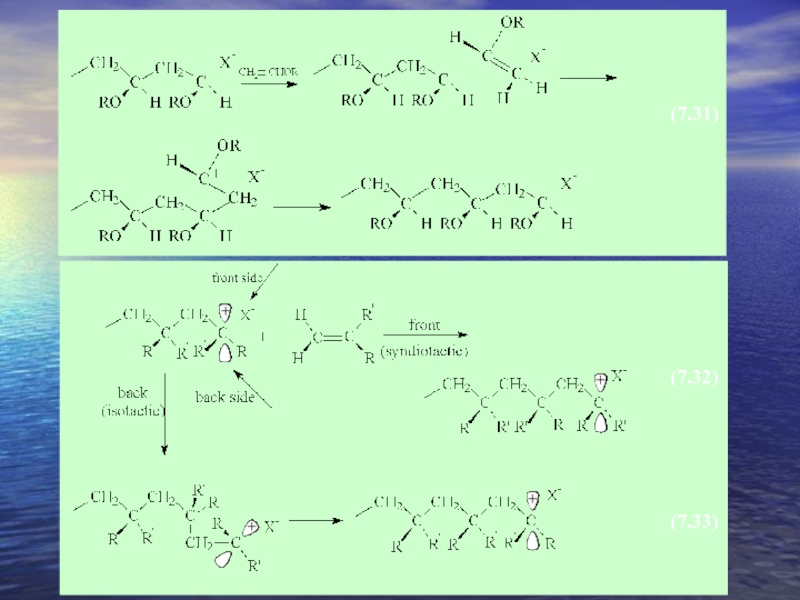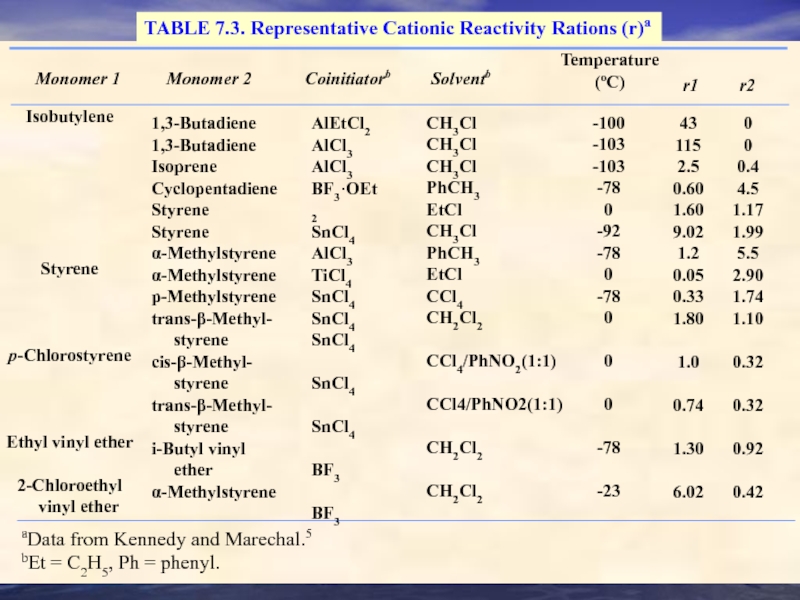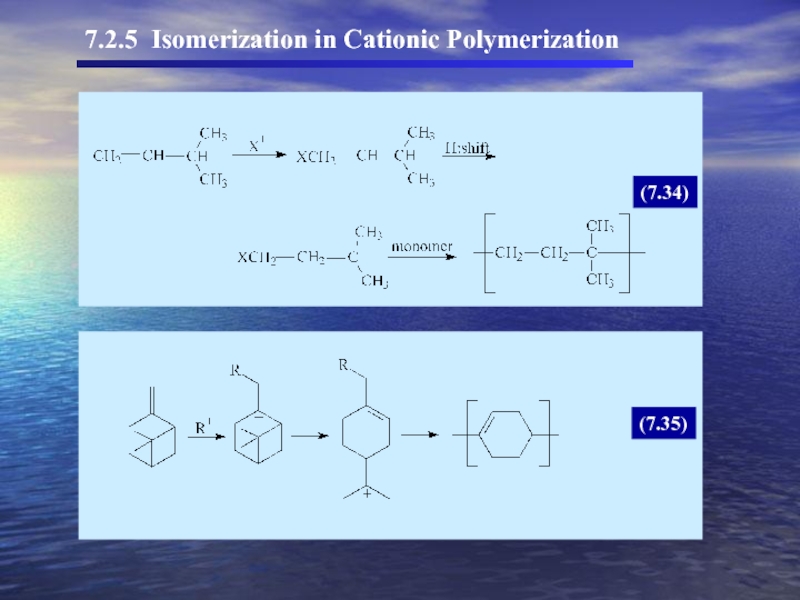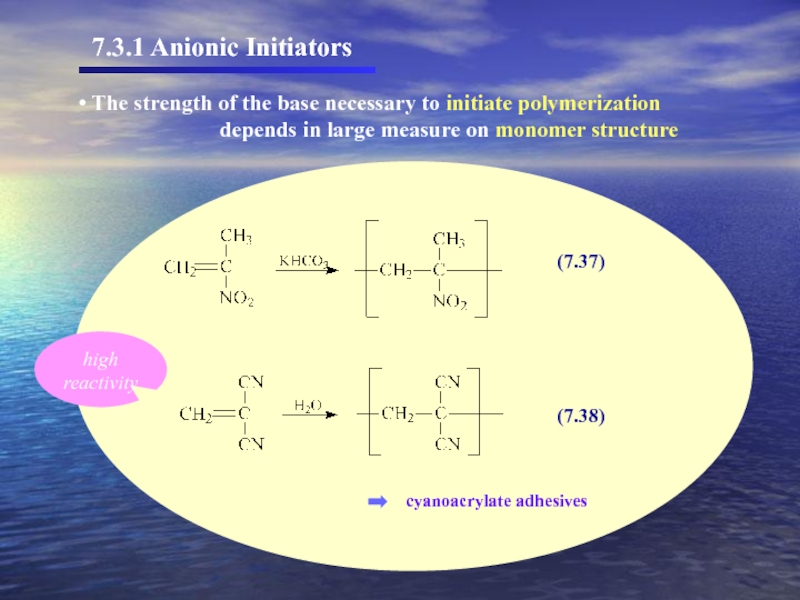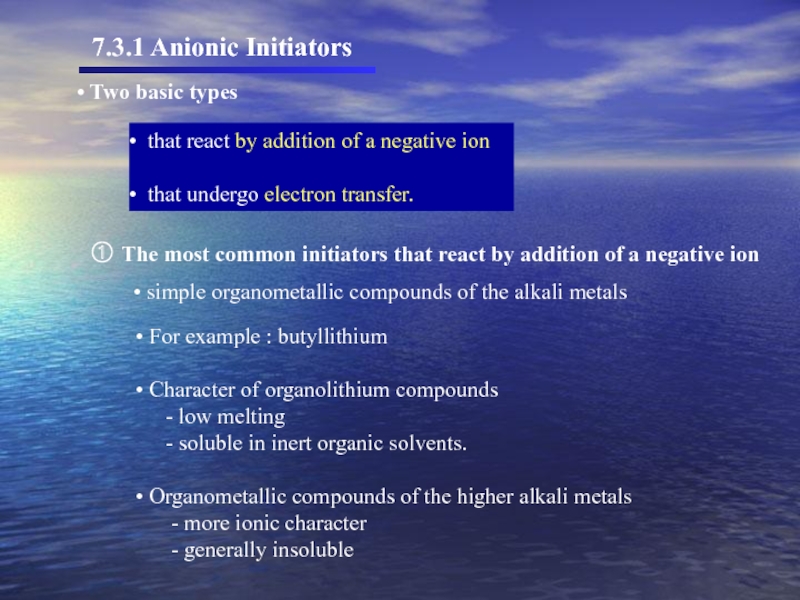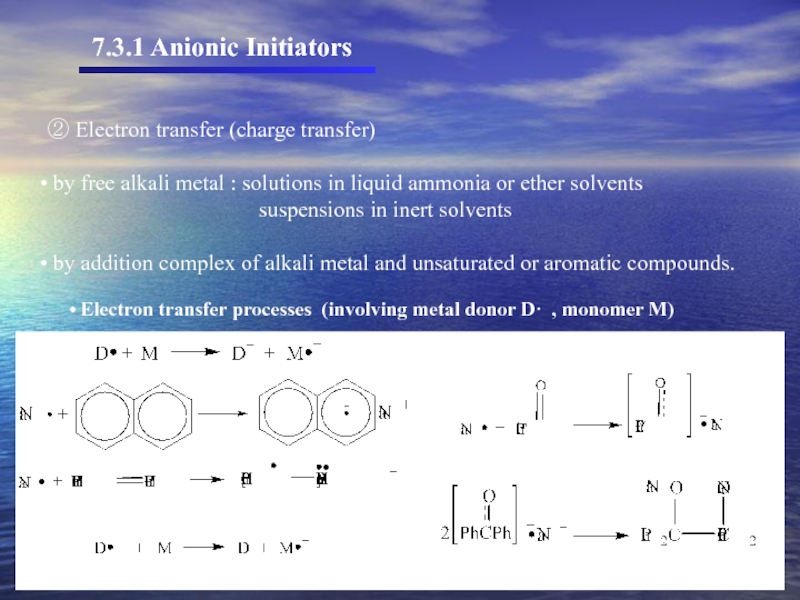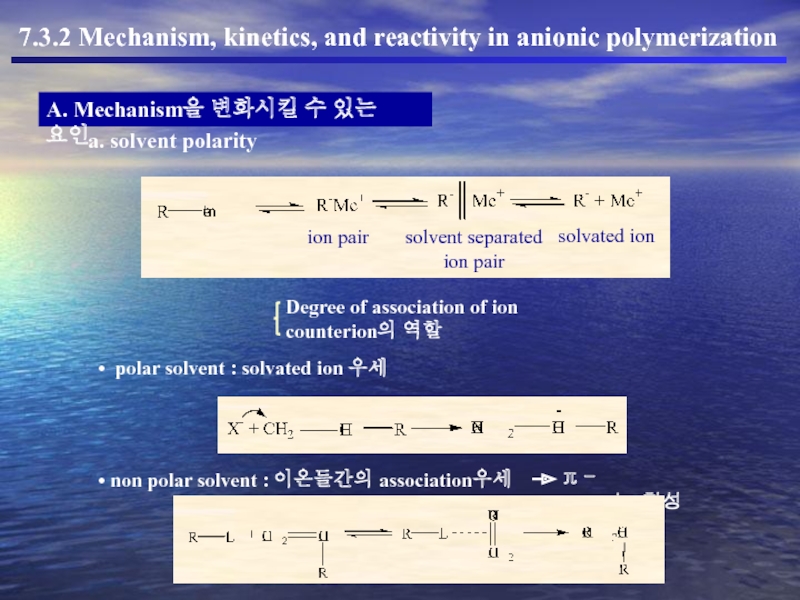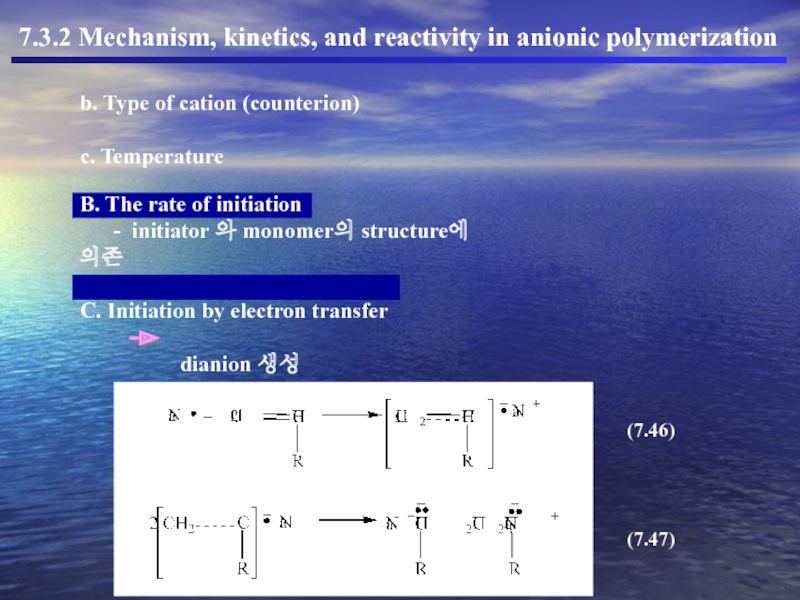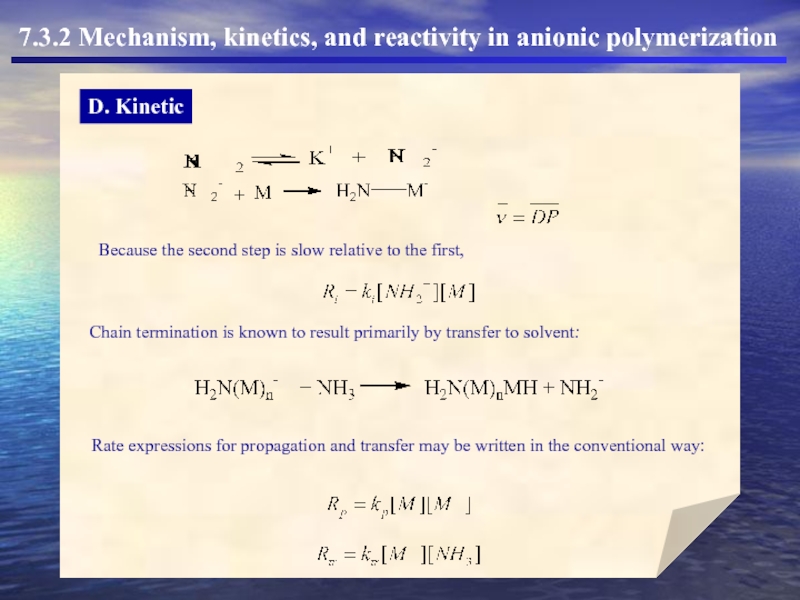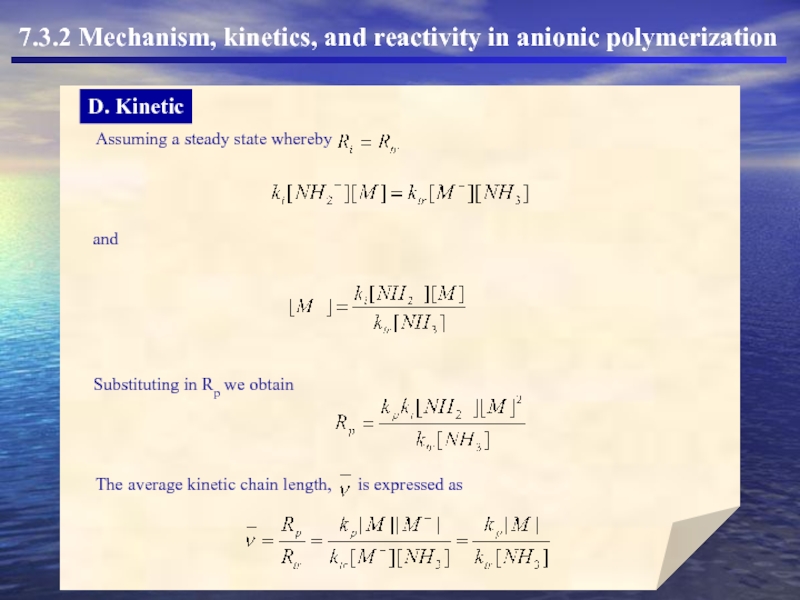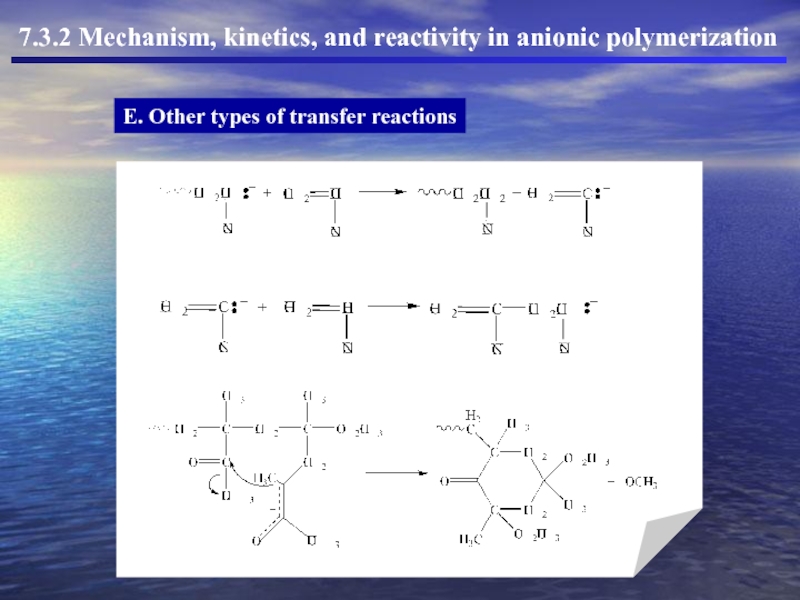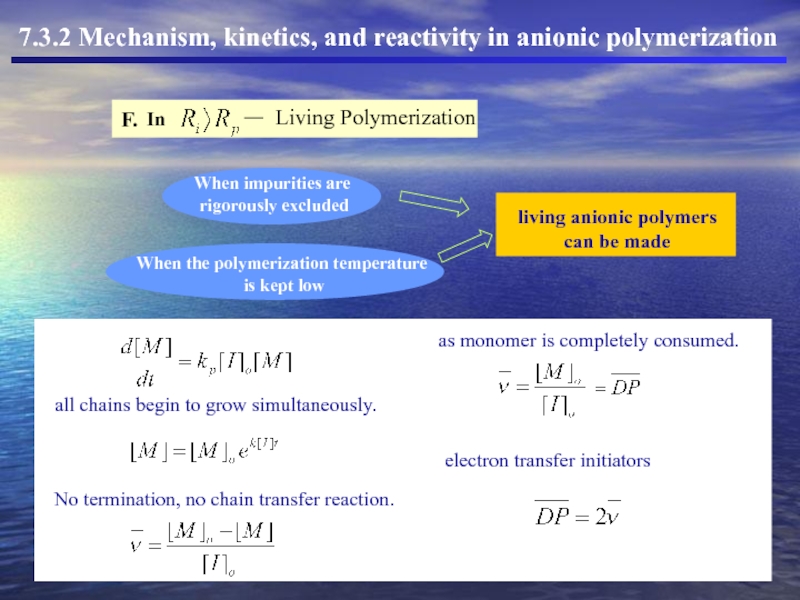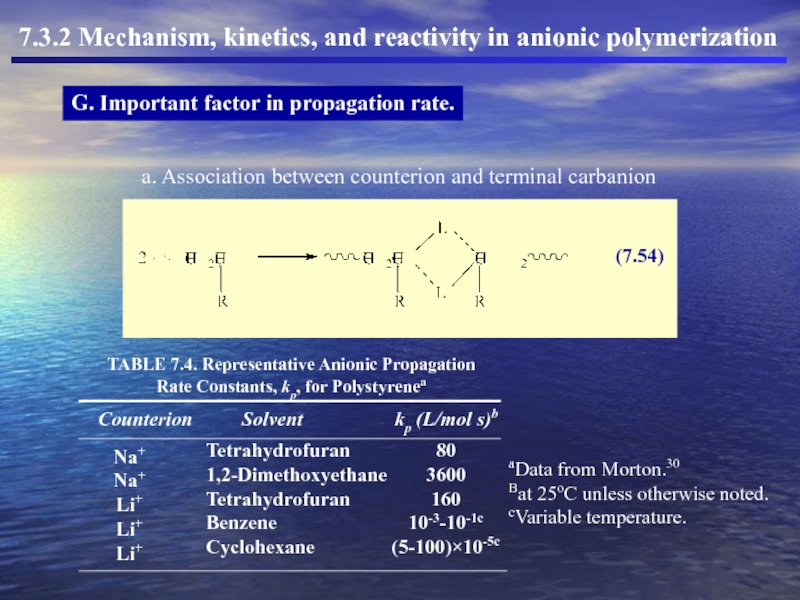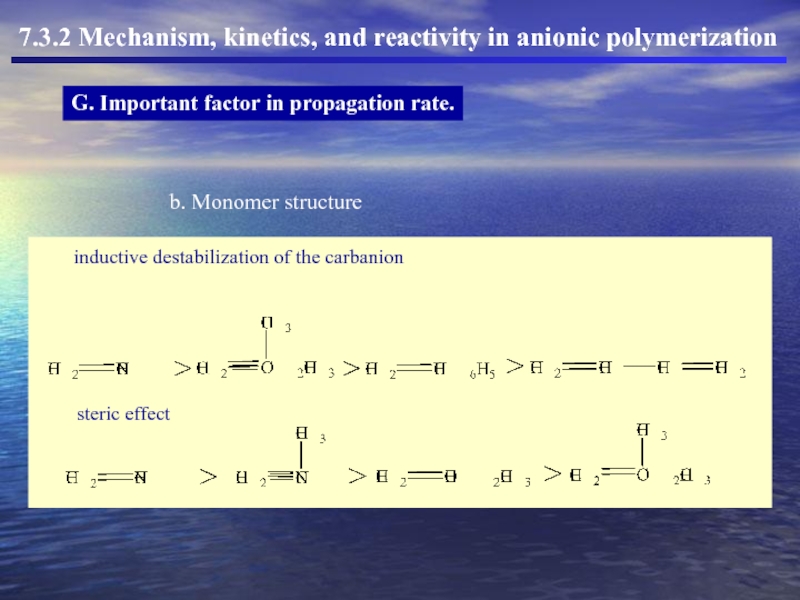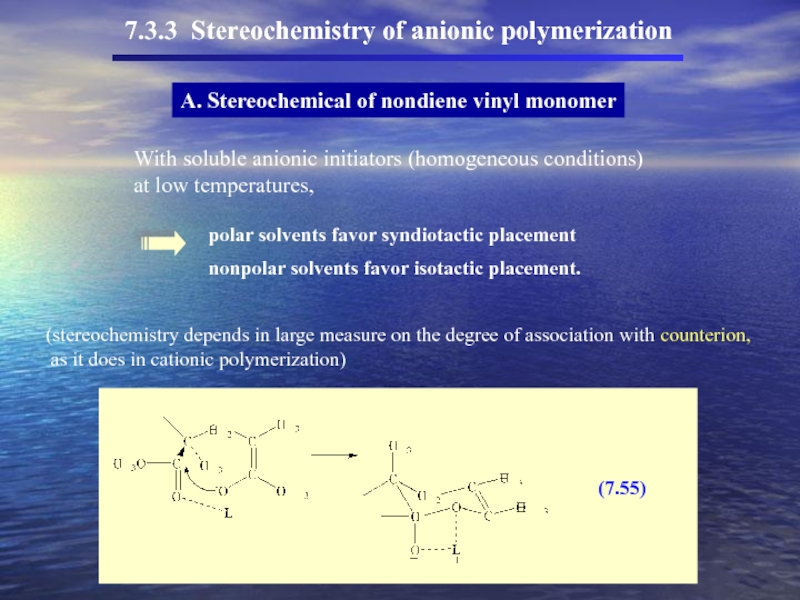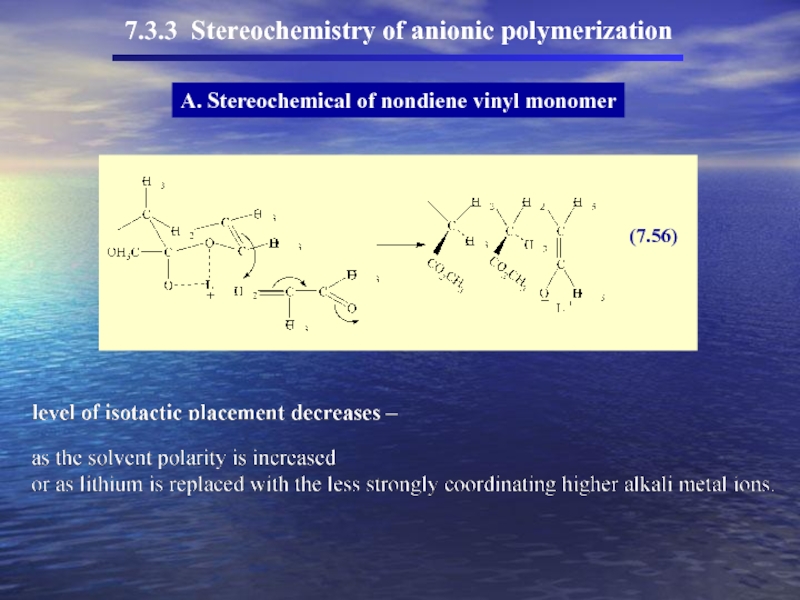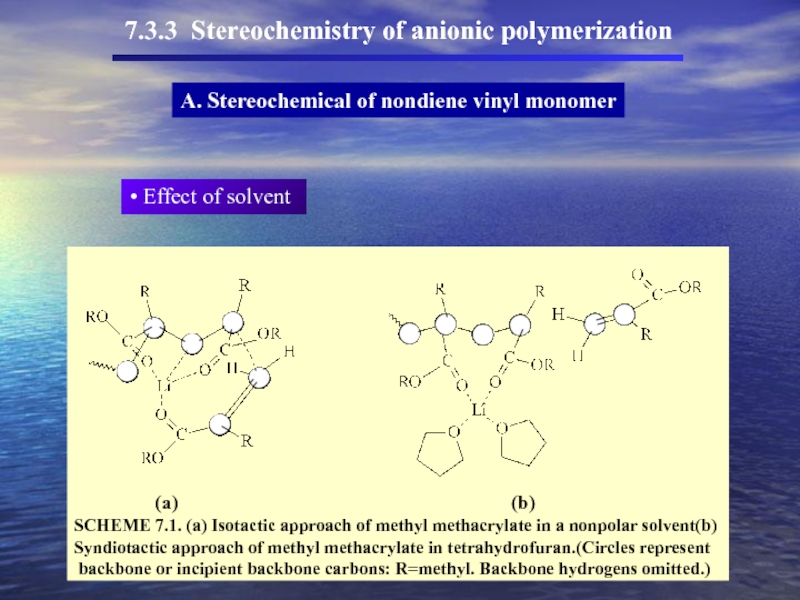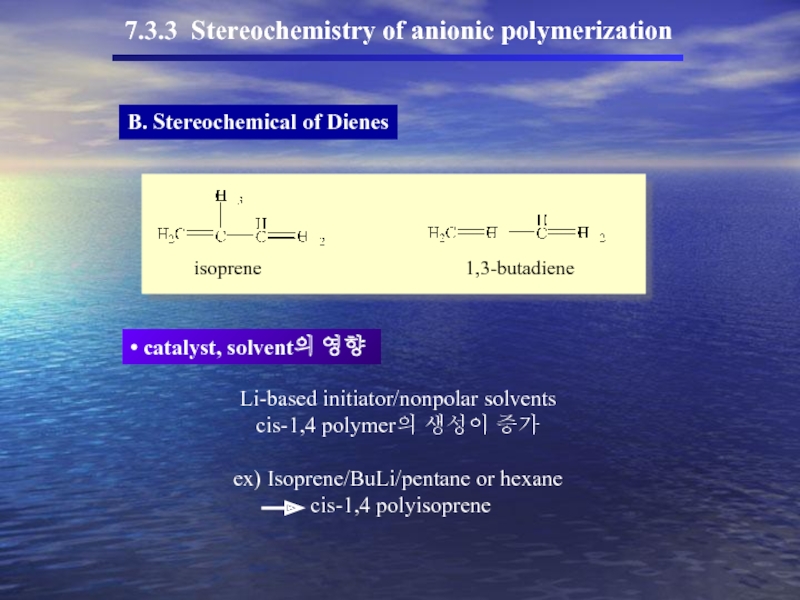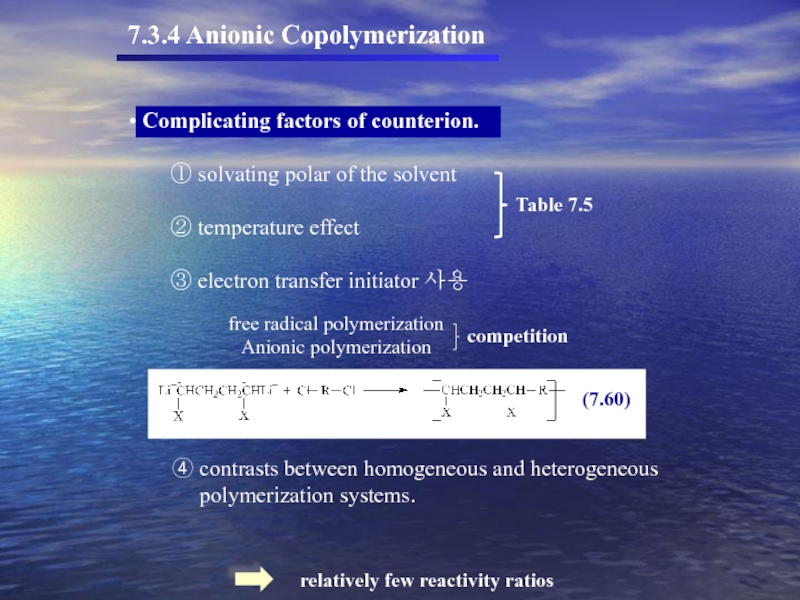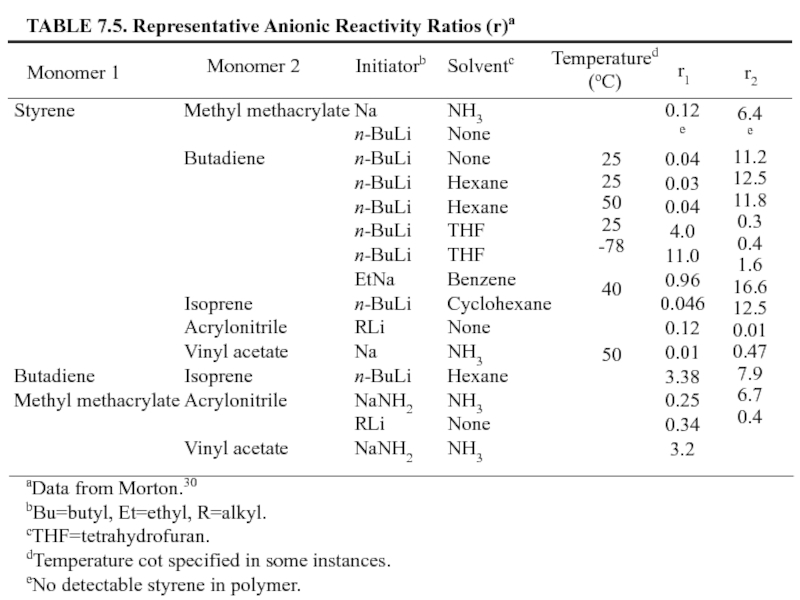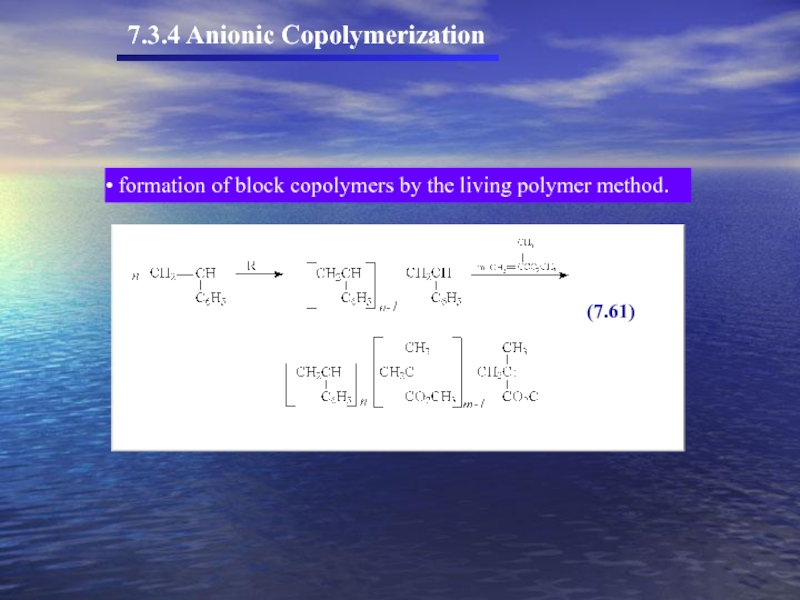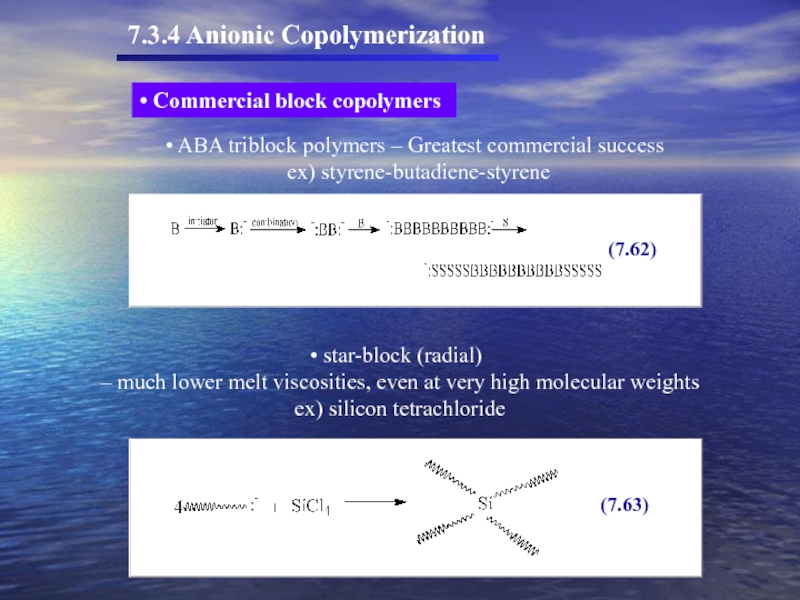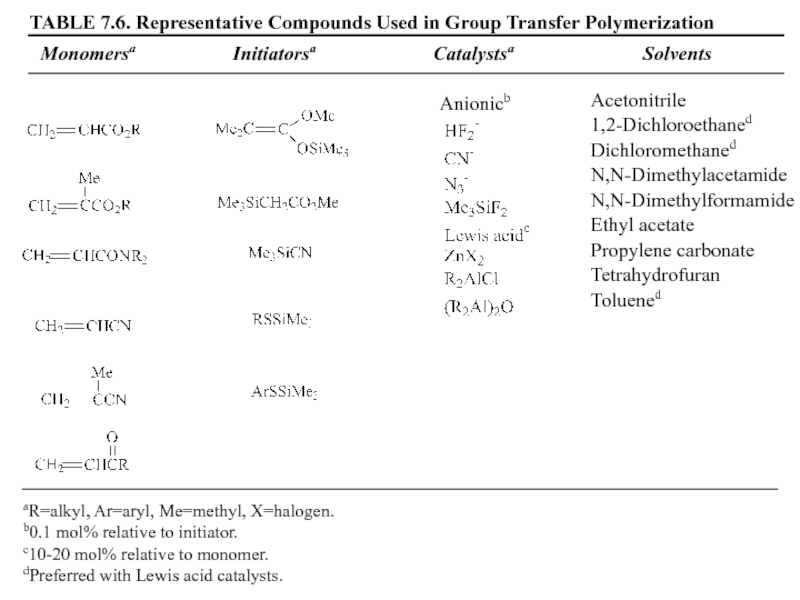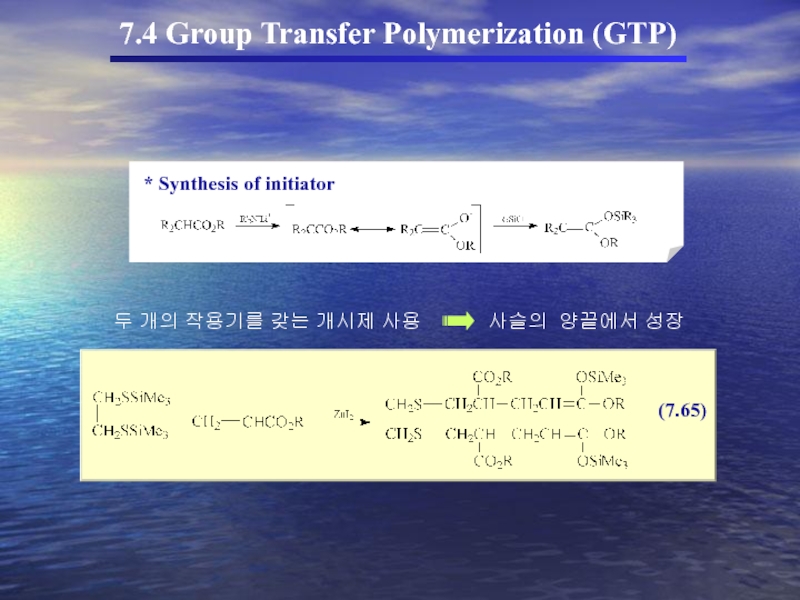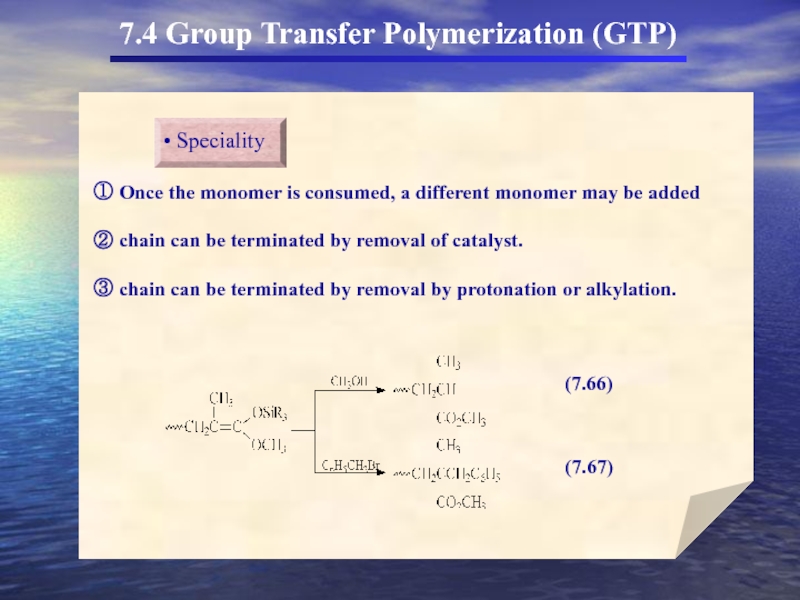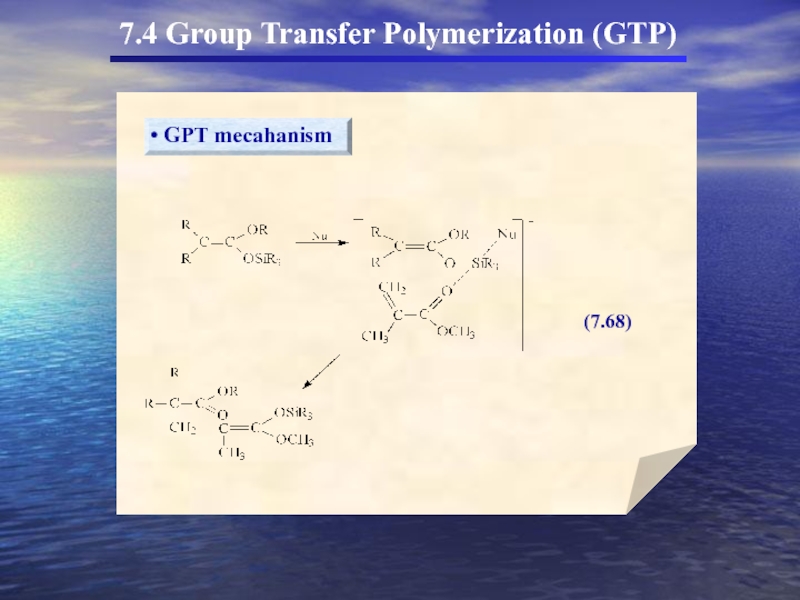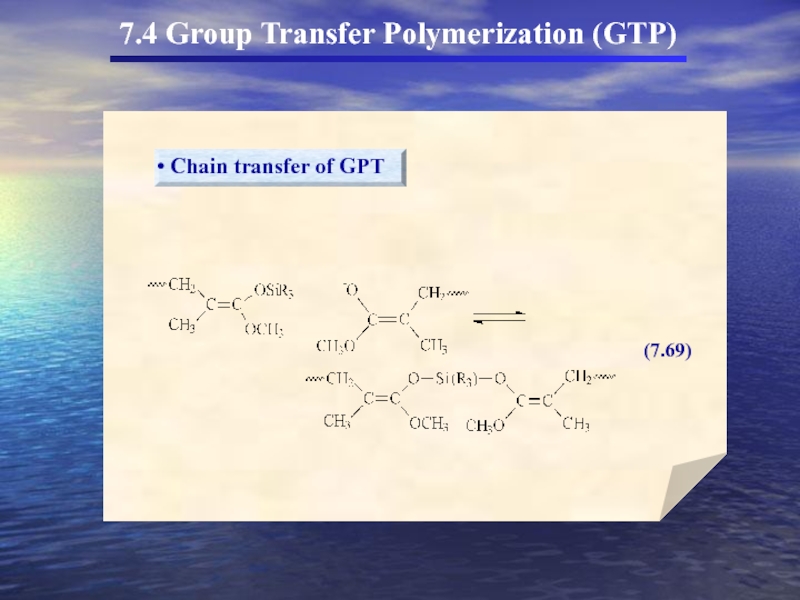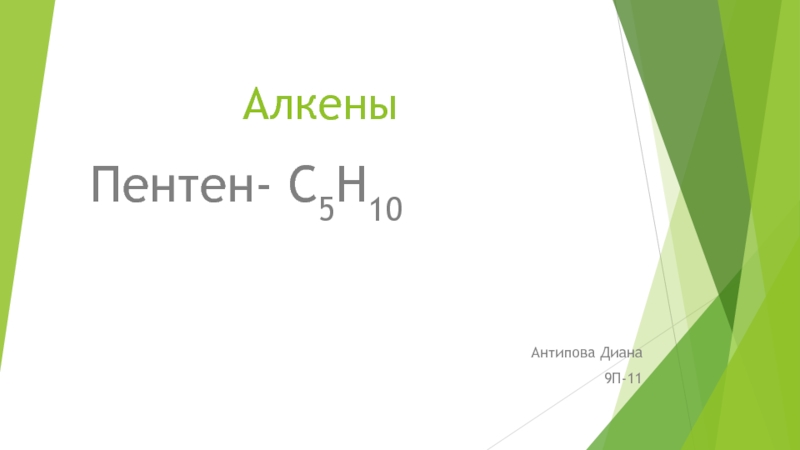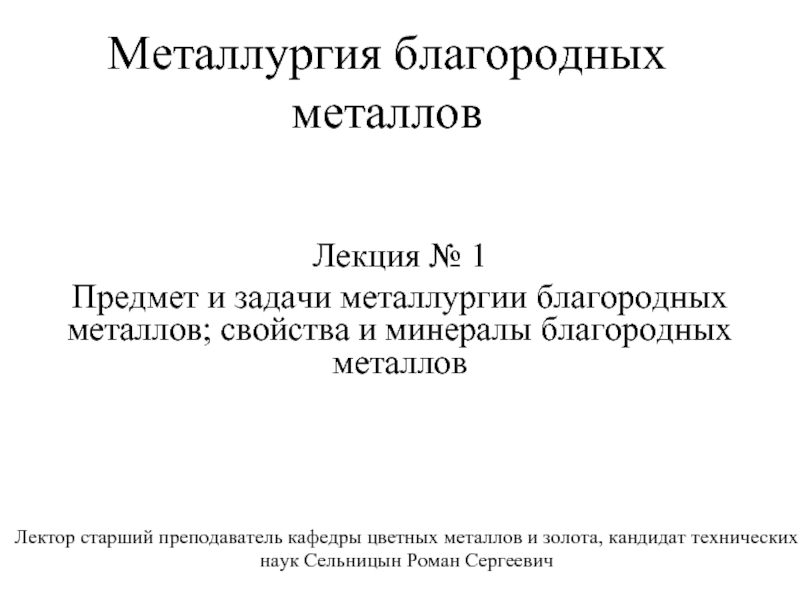- Главная
- Разное
- Дизайн
- Бизнес и предпринимательство
- Аналитика
- Образование
- Развлечения
- Красота и здоровье
- Финансы
- Государство
- Путешествия
- Спорт
- Недвижимость
- Армия
- Графика
- Культурология
- Еда и кулинария
- Лингвистика
- Английский язык
- Астрономия
- Алгебра
- Биология
- География
- Детские презентации
- Информатика
- История
- Литература
- Маркетинг
- Математика
- Медицина
- Менеджмент
- Музыка
- МХК
- Немецкий язык
- ОБЖ
- Обществознание
- Окружающий мир
- Педагогика
- Русский язык
- Технология
- Физика
- Философия
- Химия
- Шаблоны, картинки для презентаций
- Экология
- Экономика
- Юриспруденция
Ionic polymerization презентация
Содержание
- 1. Ionic polymerization
- 2. 7.1 Introduction Presence of counterions (=
- 3. 7.1 Introduction
- 4. TABLE 7.1. Commercially Important Polymers Prepared by
- 5. 7.2.1 Cationic initiators 7.2.2 Mechanism,
- 6. 7.2.1 Cationic Initiators The propagating species : carbocation Coinitiator
- 7. (7.5) (7.6) (7.7) (7.8) Other initiators 7.2.1 Cationic Initiators
- 8. Other initiators 7.2.1 Cationic Initiators
- 9. 7.2.2 Mechanism, Kinetics, and Reactivity in
- 10. 7.2.2 Mechanism, Kinetics, and Reactivity in Cationic Polymerization Carbocationic Initiation.
- 11. B. Propagation Step 7.2.2 Mechanism, Kinetics, and Reactivity in Cationic Polymerization
- 12. C. Influences polymerization rate
- 13. D. Chain transfer reaction
- 14. D. Chain transfer reaction
- 15. E. Termination reaction
- 16. F. Proton trap
- 17. G. Telechelic Polymer
- 18. H. Pseudocationic Polymerization
- 19. I. To prepare living polymers under cationic conditions.
- 20. I. To prepare living polymers under cationic conditions.
- 21. J. Kinetics
- 23. Substituting for in
- 24. K. Difference between free radical and cationic processes.
- 25. L. Nonconjugation diene – Cationic cyclopolymerization 7.2.2 Mechanism, Kinetics, and Reactivity in Cationic Polymerization
- 26. Cationic Polymerization lead to
- 27. EX) t-butyl vinyl ether
- 28. In polar solvents both ions
- 29. (7.29) (7.30) Models proposed for vinyl ether polymerization
- 31. 7.2.4 Cationic Copolymerization A. Copolymerization equation
- 32. TABLE 7.3. Representative Cationic Reactivity Rations
- 33. 7.2.5 Isomerization in Cationic Polymerization (7.34) (7.35)
- 34. 7.3 Anionic Polymerization 7.3.1 Anionic
- 35. (7.36) Propagating chain - carbanion
- 36. The strength of the base
- 37. Two basic types that react
- 38. 7.3.1 Anionic Initiators
- 39. 7.3.2 Mechanism, kinetics, and reactivity
- 40. b. Type of cation
- 41. D. Kinetic 7.3.2 Mechanism, kinetics, and
- 42. Substituting in Rp we obtain The
- 43. E. Other types of transfer reactions 7.3.2 Mechanism, kinetics, and reactivity in anionic polymerization
- 44. 7.3.2 Mechanism, kinetics, and reactivity in anionic polymerization
- 45. 7.3.2 Mechanism, kinetics, and reactivity in
- 46. 7.3.2 Mechanism, kinetics, and reactivity in anionic polymerization G. Important factor in propagation rate.
- 47. 7.3.3 Stereochemistry of anionic polymerization A.
- 48. 7.3.3 Stereochemistry of anionic polymerization A. Stereochemical of nondiene vinyl monomer
- 49. 7.3.3 Stereochemistry of anionic polymerization A.
- 50. B. Stereochemical of Dienes 7.3.3 Stereochemistry
- 51. formation of cis-polyisoprene – lithium’s
- 52. 7.3.4 Anionic Copolymerization ④
- 54. 7.3.4 Anionic Copolymerization formation of block copolymers by the living polymer method.
- 55. ABA triblock polymers – Greatest commercial
- 56. 7.4 Group Transfer Polymerization (GTP)
- 58. 7.4 Group Transfer Polymerization (GTP) 두
- 59. 7.4 Group Transfer Polymerization (GTP)
- 60. 7.4 Group Transfer Polymerization (GTP)
- 61. 7.4 Group Transfer Polymerization (GTP)
Слайд 1
Chapter 7. Ionic polymerization
7.1 Introduction
7.2 Cationic polymerization
7.3 Anionic polymerization
7.4 Group transfer
Слайд 27.1 Introduction
Presence of counterions (= gegenions)
Solvation effect
more complex than free radical polymerizations
but more versatile
Слайд 4TABLE 7.1. Commercially Important Polymers Prepared by Ionic Polymerization
Polymer or Copolymer
Cationica
(low and high molecular weight)
Isobutylene-isoprene copolymerc
(“butyl rubber”)
Isobutylene-cyclopentadiene
copolymer
Hydrocarbond and polyterpene resins
Coumarone-indene resinse
Poly(vinyl ether)s
Anionicf
cis-1,4-Polybutadiene
cis-1,4-Polisoprene
Styrene-butadiene rubber (SBR)g
Styrene-butadiene block and star
copolymers
ABA block copolymers (A= styrene,
B=butadiene or isoprene)
polycyanoacrylateh
Major Uses
Adhesives, sealants, insulating oils, lubricating oil and
grease additives, moisture barriers
Inner tubes, engine mounts and springs, chemical tank
linings, protective clothing, hoses, gaskets, electrical
insulation
Ozone-resistant rubber
Inks, varnishes, paints, adhesives, sealants
Flooring, coatings, adhesives
Polymer modifiers, tackifiers, adhesives
Tires
Tires, footware, adhesives, coated fabrics
Tire treads, belting, hose, shoe soles, flooring, coated
fabrics
Flooring, shoe soles, artificial leather, wire and cable
insulation
Thermoplastic elastomers
Adhesives
aAlCl3 and BF3 most frequently used coinitiators.
b”Polybutenes” are copolymers based on C4 alkenes and lesser amounts of propylene and C5 and higher alkenes from
refinery streams.
cTerpolymers of isobutylene, isoprene, and divinylbenzene are also used in sealant and adhesive formulations.
dAliphatic and aromatic refinery products.
eCoumarone (benzofuran) and indene (benzocyclopentadiene) are products of coal tar.
fn-Butyllithium most common initiator.
gContains higher cis content than SBR prepared by free radical polymerization.
hMonomer polymerized by adventitious water.
Слайд 5
7.2.1 Cationic initiators
7.2.2 Mechanism, kinetics, and reactivity in cationic polymerization
7.2.3 Stereochemistry
7.2.4.Cationic copolymerization
7.2.5 Isomerization in cationic polymerization
7.2 Cationic polymerization
Слайд 9
7.2.2 Mechanism, Kinetics, and Reactivity in Cationic Polymerization
Carbocationic Initiation.
addition of the electrophilic species – the more stable carbocation
(Markovnikov’s rule) intermediate is formed.
Слайд 107.2.2 Mechanism, Kinetics, and Reactivity in Cationic Polymerization
Carbocationic Initiation.
Слайд 23
Substituting for
in
, one obtains
In the absence of any chain transfer,
(the kinetic chain length = )
If transfer is the predominant mechanism controlling chain growth,
Слайд 25L. Nonconjugation diene – Cationic cyclopolymerization
7.2.2 Mechanism, Kinetics, and Reactivity in
Слайд 26
Cationic Polymerization
lead to stereoregular structures.
ex) vinyl ether
α - methylstyrene
Vinyl ether observation resulting
greater stereoregularity is achieved at lower temperatures
the degree of stereoregularity can vary with initiator
the degree and type of stereoregularity (isotactic or syndiotactic)
vary with solvent polarity.
Слайд 27EX) t-butyl vinyl ether
forms
forms mainly syndiotactic polymer in polar solvents.
( cationic chain end and the counterion are associated )
Solvent effect
Слайд 28 In polar solvents both ions
1)
2) the chain end – exist as a free carbocation surrounded by solvent molecules
In nonpolar solvents
1) association between carbocation chain end and counterion would be strong
2) counterion could influence the course of steric control.
7.2.3 Stereochemistry of Cationic Polymerization
Solvent effect
Слайд 317.2.4 Cationic Copolymerization
A. Copolymerization equation
- the situation is
B. Reactivity ratios vary with initiator type and solvent polarity.
C. Temperature – unpredictable effect
D. Steric effects (Table 7.3)
E. commercial cationic copolymers – butyl rubber
(prepared from isobutylene and isoprene.)
Слайд 32
TABLE 7.3. Representative Cationic Reactivity Rations (r)a
Monomer 1
Monomer 2
Coinitiatorb
Solventb
Temperature
(oC)
r1
r2
1,3-Butadiene
1,3-Butadiene
Isoprene
Cyclopentadiene
Styrene
Styrene
α-Methylstyrene
α-Methylstyrene
p-Methylstyrene
trans-β-Methyl-
cis-β-Methyl-
styrene
trans-β-Methyl-
styrene
i-Butyl vinyl
ether
α-Methylstyrene
AlEtCl2
AlCl3
AlCl3
BF3·OEt2
SnCl4
AlCl3
TiCl4
SnCl4
SnCl4
SnCl4
SnCl4
SnCl4
BF3
BF3
CH3Cl
CH3Cl
CH3Cl
PhCH3
EtCl
CH3Cl
PhCH3
EtCl
CCl4
CH2Cl2
CCl4/PhNO2(1:1)
CCl4/PhNO2(1:1)
CH2Cl2
CH2Cl2
-100
-103
-103
-78
0
-92
-78
0
-78
0
0
0
-78
-23
43
115
2.5
0.60
1.60
9.02
1.2
0.05
0.33
1.80
1.0
0.74
1.30
6.02
0
0
0.4
4.5
1.17
1.99
5.5
2.90
1.74
1.10
0.32
0.32
0.92
0.42
Isobutylene
Styrene
p-Chlorostyrene
Ethyl vinyl ether
2-Chloroethyl
vinyl ether
aData from Kennedy and Marechal.5
bEt = C2H5, Ph = phenyl.
Слайд 34
7.3 Anionic Polymerization
7.3.1 Anionic initiators
7.3.2 Mechanism, kinetics, and reactivity in anionic
polymerization
7.3.3 Stereochemistry of anionic polymerization
7.3.4 Anionic copolymerization
Слайд 35
(7.36)
Propagating chain - carbanion
Examples – nitro, cyano, carboxyl, vinyl,
Monomers having substituent group – stabilizing a carbanion
resonance or induction
Слайд 36
The strength of the base necessary to initiate polymerization
cyanoacrylate adhesives
high reactivity
Слайд 37 Two basic types
that react by addition of a negative
that undergo electron transfer.
① The most common initiators that react by addition of a negative ion
simple organometallic compounds of the alkali metals
For example : butyllithium
Character of organolithium compounds
- low melting
- soluble in inert organic solvents.
Organometallic compounds of the higher alkali metals
- more ionic character
- generally insoluble
Слайд 39
7.3.2 Mechanism, kinetics, and reactivity in anionic polymerization
A. Mechanism을 변화시킬 수
a. solvent polarity
ion pair
solvent separated
ion pair
solvated ion
Degree of association of ion
counterion의 역할
polar solvent : solvated ion 우세
non polar solvent : 이온들간의 association우세
π - complex형성
Слайд 40
b. Type of cation (counterion)
c. Temperature
B. The rate of initiation
C. Initiation by electron transfer
dianion 생성
7.3.2 Mechanism, kinetics, and reactivity in anionic polymerization
Слайд 41
D. Kinetic
7.3.2 Mechanism, kinetics, and reactivity in anionic polymerization
Because the second
Chain termination is known to result primarily by transfer to solvent:
Rate expressions for propagation and transfer may be written in the conventional way:
Слайд 42
Substituting in Rp we obtain
The average kinetic chain length,
is expressed
Assuming a steady state whereby
and
D. Kinetic
7.3.2 Mechanism, kinetics, and reactivity in anionic polymerization
Слайд 43E. Other types of transfer reactions
7.3.2 Mechanism, kinetics, and reactivity in
Слайд 45
7.3.2 Mechanism, kinetics, and reactivity in anionic polymerization
G. Important factor in
a. Association between counterion and terminal carbanion
Слайд 467.3.2 Mechanism, kinetics, and reactivity in anionic polymerization
G. Important factor in
Слайд 477.3.3 Stereochemistry of anionic polymerization
A. Stereochemical of nondiene vinyl monomer
With soluble
at low temperatures,
polar solvents favor syndiotactic placement
nonpolar solvents favor isotactic placement.
(stereochemistry depends in large measure on the degree of association with counterion,
as it does in cationic polymerization)
Слайд 497.3.3 Stereochemistry of anionic polymerization
A. Stereochemical of nondiene vinyl monomer
Effect
Слайд 50
B. Stereochemical of Dienes
7.3.3 Stereochemistry of anionic polymerization
catalyst, solvent의 영향
isoprene
1,3-butadiene
Li-based
cis-1,4 polymer의 생성이 증가
ex) Isoprene/BuLi/pentane or hexane
cis-1,4 polyisoprene
Слайд 51
formation of cis-polyisoprene – lithium’s ability
forming a six-membered ring transition
– “lock” the isoprene into a cis-configuration
s-cis comformation by pi complexation – hold isoprene
7.3.3 Stereochemistry of anionic polymerization
Слайд 52
7.3.4 Anionic Copolymerization
④ contrasts between homogeneous and heterogeneous
polymerization
Слайд 55 ABA triblock polymers – Greatest commercial success
ex) styrene-butadiene-styrene
star-block
– much lower melt viscosities, even at very high molecular weights
ex) silicon tetrachloride
Commercial block copolymers
7.3.4 Anionic Copolymerization
Слайд 56
7.4 Group Transfer Polymerization (GTP)
(In the 1980s a new method for
GTP의 특성
① Anionic polymerization에서 흔히 사용되는 monomer를 사용
Living polymer로 전환
② Propagating chain Covalent character
③ Organosilicon이 개시제로 사용
living polymer
Organosilicon에서 SiR3가 transfer되어 중합을 형성(GTP)
